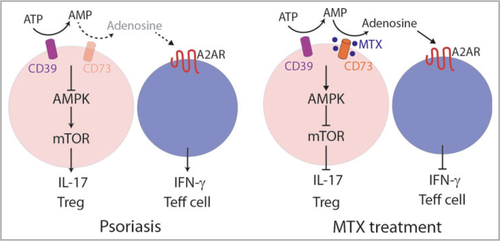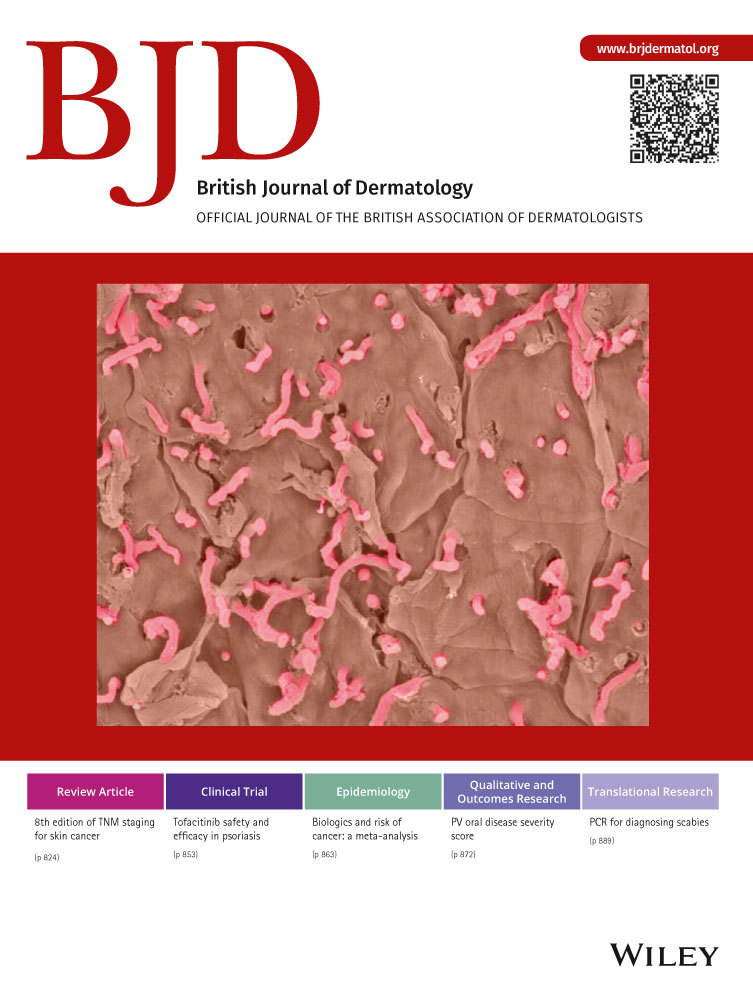Editor's Choice
Bullous pemphigoid: serum anti-BP180 IgG levels, mortality and Karnofsky score
The aim of this study was to analyse distinct autoantibody profiles for the prediction of the disease course in a well-characterized cohort of bullous pemphigoid (BP) sera. In total 143 patients from the BLISTER trial consented to participate in this serological study. Sera taken at baseline were analysed by (i) indirect immunofluorescence, (ii) anti-BP180 NC16A (16th noncollagenous domain) and anti-BP230 enzyme-linked immunosorbent assay and (iii) immunoblotting with various substrates. The results were then linked with clinical parameters including age, Karnofsky score, number of blisters, related adverse events and mortality. Disease activity correlated with IgG anti-BP180 levels but not with levels of anti-BP230 IgG or anti-BP180 IgE. High levels of both anti-BP180 IgG and anti-BP230 IgG were associated with a low Karnofsky score. The presence of anti-BP230 IgG was more frequent in older patients. Those with higher total IgE serum levels experienced fewer adverse events. Higher IgG anti-BP180 levels were associated with an increased 1-year mortality rate. The authors concluded that analysis of the autoantibody profile is not only of diagnostic relevance but may also be helpful in predicting the course of the disease.
Holtsche MM, Goletz S, van Beek N et al. Prospective study in bullous pemphigoid: association of high serum anti-BP180 IgG levels with increased mortality and reduced Karnofsky score. Br J Dermatol 2018; 179: 918–924.
DOI: 10.1111/bjd.16553
Methotrexate-activated Tregs via the CD73/AMPK/mTOR pathway
Yan and colleagues from China and the U.S.A. set out to investigate the molecular mechanism of methotrexate in the treatment of psoriasis. They isolated regulatory T cells (Tregs) and effector T cells (Teffs) from the blood of patients with psoriasis and healthy controls. The proliferation of Teffs was detected by the carboxyfluorescein succinimidyl ester assay. The interferon-γ and interleukin (IL)-17 levels were analysed by enzyme-linked immunosorbent assay. The expressions of CD73 and FoxP3 were determined by flow cytometry. The expression of proteins in the AMP-activated protein kinase (AMPK)–mammalian target of rapamycin (mTOR) pathway was detected by Western blot analysis. The data suggested that patients with psoriasis have Tregs with decreased immune suppression function and reduced expression of CD73 compared with healthy controls. Moreover, methotrexate could significantly restore the immunosuppressive function of IL-17-secreting Tregs. The authors speculated that methotrexate could restore the immunosuppressive function of Tregs through upregulating CD73, activating AMPK and inactivating the mTOR pathway. These findings may partly explain how methotrexate treats psoriasis.
Yan K, Xu W, Huang Y et al. Methotrexate restores the function of peripheral blood regulatory T cells in psoriasis vulgaris via the CD73/AMPK/mTOR pathway. Br J Dermatol 2018; 179: 896–905.
DOI: 10.1111/bjd.16560
‘It's a traumatic illness, traumatic to witness’
Orlowska and colleagues from the U.K. carried out a qualitative study of the experiences of bereaved family caregivers of patients with cutaneous T-cell lymphoma (CTCL). They explain that families often provide the care for such patients, but little is known about their experiences or needs while caring for their relative with advanced disease or in bereavement. Thus, their aim was to explore the experiences of bereaved family caregivers of patients with CTCL. They used single semistructured qualitative interviews with bereaved family caregivers of patients with CTCL from a supraregional CTCL clinic. Transcribed interviews were analysed thematically, focusing on advanced disease, the approach of death and bereavement. Caregivers often had vivid recollections of the challenges of caring for their relative with advanced CTCL and some took on quasiprofessional roles as a result. Advanced disease made high demands on both organizational flexibility and family resources. For many caregivers, seeing disease progression was a prolonged and profoundly traumatic experience. The extent to which they were prepared for their relative's death and supported in bereavement was highly variable. The authors concluded that family caregivers should be considered as part of the wider healthcare team, acknowledging their multiple roles and the challenges they encounter in looking after their relative with CTCL as the disease progresses.
Orlowska D, Selman LE, Beynon T et al. ‘It's a traumatic illness, traumatic to witness’: a qualitative study of the experiences of bereaved family caregivers of patients with cutaneous T-cell lymphoma. Br J Dermatol 2018; 179: 882–888.
DOI: 10.1111/bjd.16447
Impact of summer sun on children's health
Childhood solar ultraviolet radiation (UVR) exposure increases the risk of skin cancer in adulthood, which is associated with mutations caused by UVR-induced cyclobutane pyrimidine dimers (CPDs). Solar UVR is also the main source of vitamin D, essential for healthy bone development in children. The aim of this European study was to assess the impact of a 12-day Baltic Sea (54° N) beach holiday on serum 25-dihydroxyvitamin D3 [25(OH)D3] and CPD in 32 healthy Polish children (skin types I–IV). Blood and urine were collected before and after the holiday and were assessed for 25(OH)D3 and excreted CPD, respectively, and personal UVR exposure was measured. Diaries were used to record sunbathing, sunburn and sunscreen use. Before and after the holiday, skin redness and pigmentation were measured by reflectance spectroscopy. The average ± SD daily-exposure UVR dose was 2·4 ± 1·5 standard erythemal doses, which is borderline erythemal. The mean concentration of 25(OH)D3 increased 1·24 ± 0·19-fold from 64·7 ± 13·3 to 79·3 ± 18·7 nmol L1 (P < 0·001). The mean CPD level increased 12·6 ± 10·0-fold from 26·9 ± 17·9 to 248·9 ± 113·4 fmol μmol1 creatinine (P < 0·001). The authors concluded that a much better understanding of the risk–benefit relationships of such sun exposure is now required, and that rigorous photoprotection is necessary for children, even in Northern Europe.
Narbutt J, Philipsen PA, Lesiak A et al. Children sustain high levels of skin DNA photodamage, with a modest increase of serum 25-hydroxyvitamin D3, after a summer holiday in Northern Europe. Br J Dermatol 2018; 179: 940–950.
DOI: 10.1111/bjd.16668





